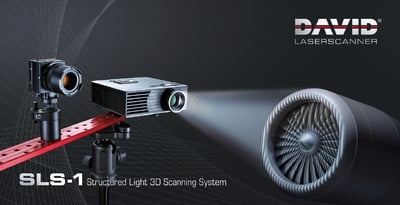 One of the more popular and accessible (read: inexpensive) 3D scanning solutions has been the DAVID Laser Scanner, which has been available for some years. Now we see a new type of scanner from German DAVID Vision Systems, the Structured Light Scanner.
One of the more popular and accessible (read: inexpensive) 3D scanning solutions has been the DAVID Laser Scanner, which has been available for some years. Now we see a new type of scanner from German DAVID Vision Systems, the Structured Light Scanner. We spoke with Eric Wilson of CreateItForMe, a growing reseller of this and other devices, to find out more about the new scanner.
Fabbaloo: Why a new scanner? Was there something wrong with the original DAVID Laser Scanner?
Eric Wilson: The DAVID laser scanner worked very well however, it is mostly manual operation where a line laser traverses for 10-40 seconds over the object with a background behind. For some applications, like human face scanning, scan time is an issue as the subjects may move slightly. The new Structured Light scan needs only 2-4 seconds, requires no laser, and does not require a background, making it safer, more mobile, flexible, and accurate for the objects being scanned.
Fabbaloo: The new Structured Light Scanner is quite a bit more expensive than the previous laser scanner; can you tell us the pricing and why such a difference?
Eric Wilson: The short answer is hardware. This package includes a very high quality camera with a fast frame rate and a lightweight DLP projector. It is designed for industrial users and I might add is considerably less expensive than other products in this market.
Fabbaloo: What are the key advantages of the new scanner over the previous device? Over alternative devices from other manufacturers?
Eric Wilson: The main advantages are:
- Fast scans, taking 2-4 seconds. Texture grabbing and other scan settings may require a few more seconds
- The projector and camera are fixed with no calibration panels during scans
- High scan accuracy and repeatability; 50-500mm parts have approx. 0.2% accuracy
- Users can scan small coins or insects to furniture and other larger objects, with the same hardware, and a simple camera position change!
- The included Shapefusion tool semi-automatically creates a 360° mesh by aligning the overlapping surface areas and fusing several scans together, and saved in one of STL, OBJ, or PLY file formats.
Because of the scan accuracy and the speed, it is suitable for reverse engineering, quality inspections, and medical use by professionals, designers, and manufacturers. The accuracy is comparable to scanners costing 10x as much.
Fabbaloo: How difficult is the assembly and setup process? What level of expertise would be necessary? How long does it take a typical user to get started?
Eric Wilson: Start up involves mounting the preassembled scanner on the tripod, connecting the cables, and aiming the camera and projector toward the object. The software installs from the USB key. The package includes detailed instructions on scanner setup and operation. Experienced DAVID users would need an hour; novice users a few hours to get started. Support is available thru DAVID Wiki and online Forum containing thousands of entries.
Fabbaloo: What is the availability of the Structured Light Scanner? Do you have them available today?
Eric Wilson: We are accepting orders now, with special introductory pricing, and shipping in about one week. If budget is an issue, users have the option of purchasing lower cost hardware and the DAVID version 3.X USB software key separately. And of course, the DAVID laser scanner kit is still available. Version 3.x upgrades are always free. Versions 2.x upgrades are available for a modest cost.
Via CreateItForMe

